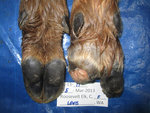


For the past 10 years, hoof rot has become an abnormally growing, rapidly spreading, debilitating disease for elk.
“It causes the hoofs on the elk to grow long, to be deformed and broken,”said National Park Service Chief Veterinarian Margaret Wild, explaining that in some cases, the whole hoof can fall off leaving the animal to walk on its bare bone.
“It’s a painful situation for the animal,” Wild said. “They become lame, they have trouble walking and keeping up with the rest of the herd. Ultimately, they lose body condition and many of them die. Not directly from the hoof lesion, but because of the lameness that it causes. They just can’t keep up and find the best places to forage and eat.”
Washington State University hired Wild to lead a state-funded research project on elk hoof disease. She plans to start the study in August, once she moves from Colorado to her new headquarters in Pullman, Washington.
Looking at maps from the Washington Department of Fish and Wildlife, Southwest Washington seems to be at the epicenter of this outbreak. Wild said there are other peculiar cases in Oregon and Washington. Just a few months ago, the first elk with the disease was discovered east of the Cascades.
“There’s a lot more to the story that we don’t know, so that’s what I’m going to be investigating,” she said.
Wild will start off by gathering information from the stakeholders and working with the Washington Department of Fish and Wildlife to develop an informative and respectful partnership with the people who hunt and enjoy viewing wildlife.
“I’m going to start off by doing a lot of listening. These are the folks who care about wildlife. They made their voice heard and were able to get funding to help address the disease,” Wild said. “It’s going to be a process that takes some time. We want to do solid, rigorous research so we can really trust the results that we get.”
Wild’s care for elk runs deep. She has studied their brain diseases for more than 30 years. This will be her first time researching hoof disease, but she believes her vast knowledge of elk and her passion will shine through.
“There are a lot of unknowns. Through studying chronic wasting disease for the last 30 years, we’ve really learned a lot. Hopefully, we will be able to do the same with elk hoof disease,” Wild said. “I care deeply about elk. That’s one of the things that drew me to this position. There is so much to be learned and there is so much opportunity to do good things and benefit the elk population and the human enjoyment of wildlife.”
Although there is no cure for elk hoof disease, Wild encourages people in the wild to do their part to prevent it from spreading. If they kill an elk with deformed hooves, cut off its legs and leave them at the site. If they are in an area where they know the disease is prevalent, they should clean their shoes and their vehicle’s tires before leaving.
“It can be challenging to take those steps to prevent the spread of the disease. If you think about the potential consequences, hopefully that helps you do the right thing,” Wild said. “We don’t know what this disease could potentially do. It is devastating for these elk. What could become worse is if it started affecting other species of wildlife as well.”
Over the next 10 years, Wild hopes to see some big breakthroughs in the study of elk hoof disease with the help of the researchers at Washington State University, the managers at the Washington Department of Fish and Wildlife and members of the community across the state.
“I would like to see a cohesive group established and together we would be addressing the disease,” Wild said. “Ten years into the future, we should be able to understand more about the causes and the contributing factors of the disease. Hopefully, we will be at a place where we can start understanding what we can do from a management standpoint to help control the disease. And then eventually, hopefully, starting to see a decrease in the prevalence and the occurrence of the disease.”